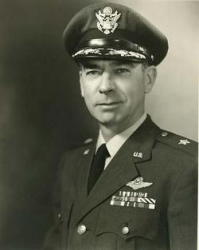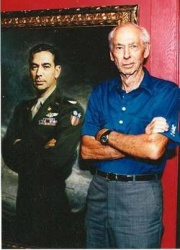
 |
|
|
||
|
Robert Lee Scott, Jr. |
||||
|
Graduate, U.S. Military Academy, Class of 1932 Engagements: • World War II (1941 - 1945) |
||||
| Biography: | ||||
|
Robert Lee Scott, Jr. Robert Lee Scott, Jr. was born on 12 April 1908 in Waynesboro, GA, the oldest of three children born to Ola and Robert Scott. As a youth, Scott was educated in Macon and became an Eagle Scout and recipient of the Distinguished Eagle Scout Award. As a youth of 3, he witnessed the fatal plane crash of pioneer aviator, Eugene Ely, in Macon. Military Career Upon graduation from the U.S. Military Academy in 1932, Scott completed pilot training at Kelly Field, TX. In October 1933, he was assigned to Mitchel Field, NY. Like other air officers, Scott flew the air mail in 1934. He also commanded a pursuit squadron in Panama and helped instruct other pilots at bases in Texas and California. After World War II began, he joined Task Force Aquila in February 1942 to fly a group of B-17 Flying Fortress bombers to the China-Burma-India Theater. Anxious to join the mission, which was to bomb Japan from China, he professed to be an experienced B-17 pilot. He actually learned to fly it enroute to Africa. Upon arrival in India, he found the mission had been scrubbed so he became stuck in India when he really wanted to be flying combat missions. Within a month, he was Executive and Operations Officer of the Assam-Burma-China (Ferry) Command, forerunner of the famous Air Transport Command, flying the Hump from India to China to supply the Kuomintang government. When the commanding officer left for China on 17 June, Scott was left in command of the operation for several days. Still anxious to get into combat and wishing to learn the Flying Tigers' tactics, he obtained, from Claire Chennault, the use of a Republic P-43 Lancer assigned to the Flying Tigers. He flew at least one high altitude mission over Mt. Everest, as described in the opening pages of his auto-biography, God Is My Co-Pilot. Scott began flying missions with the Flying Tigers, flying a P-40 as a single-ship escort for the transports and flying ground attack missions. During this period, he frequently repainted the propeller spinner in different colors to create the illusion of a much larger fighter force in the area than a single aircraft becoming, in effect, a "one-man air force." In July 1942, at the request of Generalissimo Chiang Kai-Shek, Scott was named Commander of the newly-formed 23rd Fighter Group, formed by General Claire Chennault when the Flying Tigers were incorporated into the USAAF. Popular accounts stated that Scott inherited command of the Flying Tigers, which actually disbanded that same month. The 23rd later become part of the 14th Air Force. Colonel Scott flew 388 combat missions in 925 hours from July 1942 to October 1943, shooting down 13 Japanese aircraft to become one of America's earliest fighter aces of WWII. Scott was ordered back to the U.S. in October 1943 as Deputy for Operations at the Army Air Force School of Applied Tactics at Orlando Army Air Base, FL. He returned to China in 1944 to fly fighter aircraft equipped with experimental rockets directed against Japanese supply locomotives in eastern China. As the war ended, he went to Okinawa to direct the same type of strikes against enemy shipping. Postwar Scott then returned to the U.S. for staff duty in Washington, DC, and other stations until the period of 1947-49 when he commanded the Jet Fighter School at Williams AFB, AZ. In 1951, he was reassigned to West Germany as Commander of the 36th Fighter-Bomber Wing at Fürstenfeldbruck Air Base. Scott graduated from the National War College in 1954 and was assigned to the Deputy Chief of Staff for Plans at Headquarters U.S. Air Force, and then to the position of Director of Information under the Secretary of the Air Force. In October 1956, he was assigned to Luke AFB, AZ, as Base Commander. Scott retired from the U.S. Air Force as a Brigadier General on 30 September 1957. Retirement Scott remained in Arizona until the 1980s and then moved to Warner Robins, GA, where he remained until his death in 2006. General Scott wrote about a dozen books including God Is My Copilot and The Day I Owned the Sky. Scott continued to be active well into his retirement. In 1984, he flew an F-16 Falcon jet fighter, and in 1995, an F-15 Eagle. On his 89th birthday in 1997, he flew in a B-1B Lancer bomber. Medals and Awards Distinguished Flying Cross (11 Awards) Badges Command Pilot Badge Honors During the 1996 Summer Olympics in Atlanta, GA, Scott carried the Olympic Flame along a section of Georgia Highway 247 that is named in his honor. Death and Burial Brigadier General Robert Lee Scott, Jr. died on 27 February 2006 at Warner Robins, GA. He is buried at Arlington National Cemetery in Arlington, VA. |
||||
| Honoree ID: 3056 | Created by: MHOH | |||
Ribbons
Medals
Badges
Honoree Photos
 |  |  |
 |  |
 |


